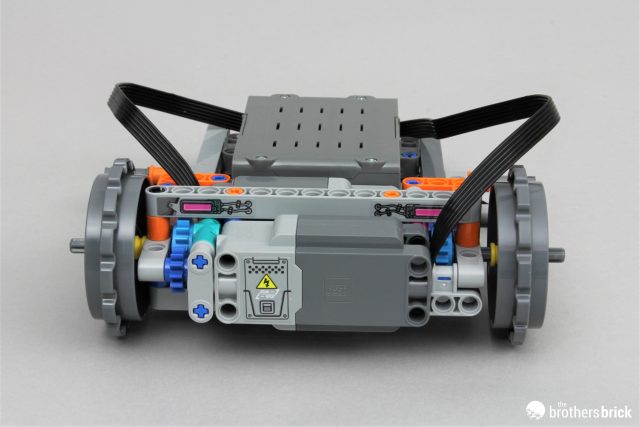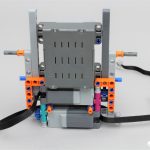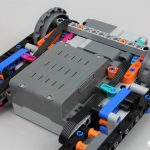When you can’t decide if your next ride should be a racer or a utility vehicle, why not make it both? And add the ability to flip?! The latest wave of LEGO Technic vehicles includes lots of colors (especially orange) and a solid range of features, from almost none to loads. The LEGO Technic 42140 App-Controlled Transformation Vehicle falls right in the middle of that range, as this wave’s sole RC car. Join us as we hop in the cockpit of this 772-piece set, which is available now and retails for US $139.99 | CAN $179.99 | UK £114.99.
The LEGO Group provided The Brothers Brick with an early copy of this set for review. Providing TBB with products for review guarantees neither coverage nor positive reviews.
Unboxing the parts, instructions, and sticker sheet
While this is not the first time we’ve seen it done, the box is somewhat unique in that the front and back both present as the main side (for the most part). They both have the customary “front-facing” title lines in the top left. But the racing model stands out as more of the front because the thumb-punch tabs are on the opposite face. The only other difference is the battery and app information.
Inside the box are 5 bags numbered 1-4 (two #2’s). Also included are the electronics (we’ll get to those in a minute) and the awesome new 19×3 Technic frame.
The sticker sheet is dense and colorful! There are over 30 stickers in total, but they’re pretty rad. The new neon yellow is already popping here, with lots of additional fun details.
The build
The build kicks off with an introduction to the electronic components. If you’re unfamiliar with the new Powered Up Technic hub, this little guy is fairly compact, aside from its mounting wings. It’s 9x9x5 studs in dimension and boasts 4 input/output ports as opposed to the 2-port System hub. The Bluetooth, app-driven hub also requires 6 AA batteries, which for some is an irritant. When creating your own models you must take the vehicle apart to access the door, or otherwise build the model with the back of the hub exposed, as we’ll learn is the case with this kit. A rechargeable insert would allow for greater versatility in terms of port placement and opening size for access. Of course, this unit is expensive on its own, and adding a rechargeable function would be even more pricy.
The kit also comes with a pair of Large Technic motors, which have a fair bit of torque. There is a lot to be said about comparisons between the various LEGO electronic components, as well as their pros and cons. But we’ll save the in-depth discussion on Powered Up and Power Functions components and their capabilities for another day. Let’s just say, they suit their purpose fairly well in this case.
Newer parts that come in this set include the grey 11L perpendicular Technic beam (only seen the UCS 75313 AT-AT), and the previously mentioned black 19×3 frame (only seen in the 42141 McLaren Formula 1 Race Car). Brand new parts are the azure 20-tooth and blue 12-tooth standard gears – welcome additions to the Technic gear family.
After our introduction of the first set of new parts, we jump into building. The designers chose to go with two different colors of 3×3 Technic biscuits to help the builder keep track of where things are. It’s a very welcome trait, as it’s easy to get lost in this topsy-turvy build.
The motors are connected to the hub with several larger beams.
Then we add an assembly on each side that moves freely. These will eventually act as our guides for the track. It’s at this point that we also put on our first set of wheel cogs.
From there we begin creating the vertical element of the vehicle’s skeleton. We also contain those wires with clips and plug them in so they’re not flopping all over the place. The build continues to have colored indicators for the right and left sides.
The end of the first bag concludes with the addition of the front wheel cogs. We also fold out those side assemblies at their unique angles and attach beam supports for the track guides.
Our next set of new parts is a fun one! We get our first Technic taste of that blinding new neon yellow. It comes in the form of 13L and 7L beams, as well as the tiny new 1x panels. As you can see in the GIF and images below, these parts fluoresce under UV light. It burns the eyes, but in a good way! Other parts to note include right and left 3×7 Technic fairing panels, a 2×5 quarter ellipse, and that tiny panel, all in blue. Finally, a pair of white 11L flexible axles haven’t been seen since in 20 years. (Last in the Williams F1 Team Racer, and before that, the Star Wars Droid Developer Kit from 1999.)
The next set of bags goes back to the small stuff, which includes the lever you push to turn the hub on (green). After that, we build the frame for the truck side of the model.
Admittedly, I got tripped up here. I originally built it backward (not pictured) because I missed a “flip” step. Again, it feels like an easy thing to do in this set – or maybe I was just distracted. Regardless, at this point, the model looks strange and isn’t very photogenic…
But there are some fun details. The stickers actually look pretty cool as they go on, with that neon yellow really popping. It sets off the blue and magenta perfectly. The paint rollers for controls are a great touch and a perfect dichotomy with the flip side.
It is at this point that we add the two sections together, along with the springs and rubber band that give the model its flipping mechanism. These components provide the perfect amount of resistance to not simply shift on their own. It takes just the right amount of force to transform the model.
This is a fairly fast build! Already, we are just about there! The finishing touches go onto the race vehicle in the form of those soft axles as “roll bars”, decorated panels, and a retractable rear spoiler.
On the flip side, the Unimog-style vehicle doesn’t have as many fancy details. In fact, it’s pretty plain. But I do like the use of stickers on BOTH sides of the side panels. It gives it a really unique look and capitalizes on the surface area.
The wheel guides are finally added, and it’s nice to see a great deal of flexibility in terms of the range of motion.
We finish up the build with the addition of a whopping 96 tread elements (48 on each side). Each one has a single rubber button attachment for added traction. The latter of those elements is the highest quantity in any set. The former stands amongst the giants in terms of quantity in memorable tracked Technic vehicles.
The completed model
While the set was not very photogenic in the build phase, it looks pretty complete! At least, the racer does. This thing looks like it’s ready to tear up the dunes.
On the flip side, the Unimog-esque vehicle doesn’t look quite as fancy. But it does seem to fit the artic vibe that the designers were going for. If it weren’t for the fact that this vehicle is designed to be flipped, that utility bed could come in handy!
And now we can finally give it a whirl! The vehicle certainly is agile. The independent tracks give it the ability to make tight turns, and it’s pretty quick. Perhaps not quite as fast as anticipated, but fast enough to be fun.
It’s clear that power is more important than speed. The number one feature of the vehicle is most certainly the flip. You might be entertained all day simply finding fun things to flip against. It can also carry a little bit of weight and navigate over the top of minor obstacles.
The app
“Control+” is the app of choice for LEGO Technic vehicles. While the electronics can be used (and perform programs) with the regular Powered Up app, this platform is intended for specific models. In terms of visibility and bigger buttons, it works best with tablets but can work well on newer phones too. Older phones might have some trouble. I was using an iPad mini.
When you click on a model, it shows you how to connect it, as well as help troubleshoot any connection issues.
Each vehicle has a custom controller. In terms of this model, it technically has two designs, but they function identically. Each model also opens with a tutorial on how to use that particular controller. At the top, it gives some nice positional feedback from the gyro sensor in the hub.
The interface is more than just a controller, though. In addition to basic navigation, the app includes a gaming feature. For the colorful racer, the goal is to find as many gates before time runs out. These gates are invisible and can only be found through on-screen radar. There are some downsides to this. First, the radar disappears frequently, making it tough to find the gates. Second, you need a relatively big space to drive around in. Third, it takes lots of practice to be nimble enough to land right on the gates – touching them doesn’t count, you must actually go through the tiny center. Admittedly, I was terrible at this game.
On the literal flip side, the Unimog was way easier and more fun! In this version, you must find power cells. The radar doesn’t disappear. Instead, it’s like the “hot/cold” game where you receive feedback for getting warmer (closer to the target). You also get to continue playing for as long as you can collect power cells; the time limit is not fixed. Also, the power cell is a larger area and easier to “pick up” than going through the tiny gates.
The app keeps track of your performance on your own personal leaderboard. Another fun feature is the ability to see overall model stats. This part of the app tells you things such as how far you’ve driven, how long, and how many flips you’ve done. You can even change the units of measurement.
Conclusions and recommendations
So at the end of the day, is this a set that you should consider purchasing? It’s not cheap, but Technic sets tend to be a bit more expensive in general due to their complex parts. Also, any set with electronic components is going to quickly drive up your cost. That said, if you’re looking for these electronics, getting them in a set like this one is less expensive than getting them individually. Other than that, what you see is what you get, so if you like the look, go with your gut.
If you’re a parent looking for a kiddo, I would say that the fun-factor is high in any RC set. This one is easy to build (other than the chance of getting lost because it looks weird while it’s being built) and tons of fun to drive/flip. The app appears to be simple yet solid enough, and the batteries are easy to swap. I would say it’s a worthwhile consideration. But if the price tag scares you and the RC feature isn’t a must, I’d definitely consider the 42139 All-Terrain Vehicle instead. It has nearly as many parts, tons of play features, and is far less expensive.
While you’re here, take a look at some of our other LEGO Technic reviews including:
- 42130 BMW M 1000 RR K66
- 42131 Cat D11 Bulldozer
- 42141 McLaren Formula 1 Race Car
- 42100 Liebherr R 9800 Excavator
The LEGO Technic 42140 App-Controlled Transformation Vehicle is available now for US $139.99 | CAN $179.99 | UK £114.99.
The LEGO Group provided The Brothers Brick with an early copy of this set for review. Providing TBB with products for review guarantees neither coverage nor positive reviews.




















































































































Looks like someone forgot a -read-more- tags, the whole review is now on the frontpage.
What, you mean you don’t like scrooooooolllllllliiiinnngggg….
The fun factor might be high in most R/C sets, but not when I need to hand my kiddo my smartphone to use it. Blech. Lego, please bring back controllers as standard parts included with these sets!